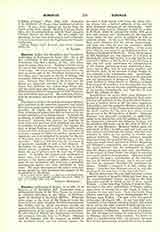

Himerius (called also EUMERIUS and COMERIUS), Archbishop of Tarragona in Spain, 385. He is the first archbishop of this province subsequent to St. Fructuosus, who died a martyr, January 21, 259, whose name has come down to us. Nothing is known about the acts of this bishop, not even the beginning or end of his reign. He is not mentioned among those who took an active part in the Priscillian controversy of that time, nor is his name in the list of bishops who assembled (380) at Saragossa in the Province of Tarragona. Because Pope Siricius in his letter uses the phrase pro antiquitate sacerdotii tui, it might be inferred that Himerius was bishop long before 385; still the words may refer to his dignity as archbishop. Himerius had sent several questions to Pope Damasus, who died before their arrival. His successor, Siricius, took up the matter, and sent an answer dated February 10, 385.
This answer, which is the first known papal decretal, gives solutions to the questions proposed, and orders Himerius to make known the enactments to the other churches. It forbids the rebaptizing of converts from Arianism and orders that they be received by the simple imposition of the bishop’s hand. It forbids the conferring of solemn baptism except at Easter and Pentecost; demands that petition for baptism be made forty days previous to its reception, and that it be preceded by prayers and fasting; but enjoins the duty of giving baptism as quickly as possible to infants and others in danger of death. No one is allowed to marry a woman betrothed to another; apostates, if repentant, are to be subjected to penance for the rest of their lives, but at the hour of death they are to be reconciled. Rules are laid down for the treatment of all penitents, especially of such as had relapsed. It determines the age of thirty-five for those to be ordained priests, requiring the reception of baptism before the age of puberty and the receiving of minor orders. It permits the acolyte and subdeacon to marry once, and then with a virgin, but requires celibacy of the deacon and priest; inflicts severe penalties on the incontinent and condemns to perpetual incarceration monks and nuns unfaithful to their vows. The pope also expresses his earnest wish that monks known for their prudence and sanctity of life be admitted to the clergy.
FRANCIS MERSHMAN

